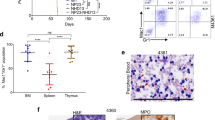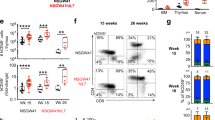Abstract
Cloning from somatic cells is inefficient, with most clones dying during gestation1,2. Cloning from embryonic stem (ES) cells is much more effective, suggesting that the nucleus of an embryonic cell is easier to reprogram3,4,5,6,7. It is thus possible that most surviving clones are, in fact, derived from the nuclei of rare somatic stem cells present in adult tissues, rather than from the nuclei of differentiated cells, as has been assumed1,8,9. Here we report the generation of monoclonal mice by nuclear transfer from mature lymphocytes. In a modified two-step cloning procedure, we established ES cells from cloned blastocysts and injected them into tetraploid blastocysts to generate mice. In this approach, the embryo is derived from the ES cells and the extra-embryonic tissues from the tetraploid host6. Animals cloned from a B-cell nucleus were viable and carried fully rearranged immunoglobulin alleles in all tissues. Similarly, a mouse cloned from a T-cell nucleus carried rearranged T-cell-receptor genes in all tissues. This is an unequivocal demonstration that a terminally differentiated cell can be reprogrammed to produce an adult cloned animal.
This is a preview of subscription content, access via your institution
Access options
Subscribe to this journal
Receive 51 print issues and online access
$199.00 per year
only $3.90 per issue
Buy this article
- Purchase on Springer Link
- Instant access to full article PDF
Prices may be subject to local taxes which are calculated during checkout


Similar content being viewed by others
References
Rideout, W. M. III, Eggan, K. & Jaenisch, R. Nuclear cloning and epigenetic reprogramming of the genome. Science 293, 1093–1098 (2001)
Solter, D. Mammalian cloning: advances and limitations. Nature Rev. Genet. 1, 199–207 (2000)
Wakayama, T., Rodriguez, I., Perry, A. C., Yanagimachi, R. & Mombaerts, P. Mice cloned from embryonic stem cells. Proc. Natl Acad. Sci. USA 96, 14984–14989 (1999)
Rideout, W. M. et al. Generation of mice from wild-type and targeted ES cells by nuclear cloning. Nature Genet. 24, 109–110 (2000)
Humpherys, D. et al. Epigenetic instability in ES cells and cloned mice. Science 293, 95–97 (2001)
Eggan, K. et al. Hybrid vigor, fetal overgrowth, and viability of mice derived by nuclear cloning and tetraploid embryo complementation. Proc. Natl Acad. Sci. USA 98, 6209–6214 (2001)
Wakayama, T. & Yanagimachi, R. Mouse cloning with nucleus donor cells of different age and type. Mol. Reprod. Dev. 58, 376–383 (2001)
Weissman, I. L. Stem cells: units of development, units of regeneration, and units in evolution. Cell 100, 157–168 (2000)
Liu, L. Cloning efficiency and differentiation. Nature Biotechnol. 19, 406 (2001)
Gurdon, J., Laskey, R. & Reeves, O. The developmental capacity of nuclei transplanted from keratinized skin cells of adult frogs. J. Embryol. Exp. Morphol. 34, 93–112 (1975)
DiBerardino, M. Genetic stability and modulation of metazoan nuclei transplanted into eggs and oocytes. Differentiation 17, 17–30 (1980)
Briggs, R. & King, T. Changes in the nuclei of differentiating endoderm cells as revealed by nuclear transplantation. J. Morphol. 100, 269–311 (1957)
McCreath, K. J. et al. Production of gene-targeted sheep by nuclear transfer from cultured somatic cells. Nature 405, 1066–1069 (2000)
Wabl, M. R., Brun, R. B. & Du Pasquier, L. Lymphocytes of the toad Xenopus laevis have the gene set for promoting tadpole development. Science 190, 1310–1312 (1975)
Wakayama, T., Perry, A. C., Zuccotti, M., Johnson, K. R. & Yanagimachi, R. Full-term development of mice from enucleated oocytes injected with cumulus cell nuclei. Nature 394, 369–374 (1998)
Galli, C. Mammalian leukocytes contain all the genetic information necessary for the development of a new individual. Cloning 1, 161–170 (1999)
Rajewsky, K. Clonal selection and learning in the antibody system. Nature 381, 751–758 (1996)
Kisielow, P. & von Boehmer, H. Development and selection of T cells: facts and puzzles. Adv. Immunol. 58, 87–209 (1995)
Nagy, A., Rossant, J., Nagy, R., Abramow-Newerly, W. & Roder, J. C. Derivation of completely cell culture-derived mice from early-passage embryonic stem cells. Proc. Natl Acad. Sci. USA 90, 8424–8428 (1993)
Kawase, E., Yamazaki, Y., Yagi, T., Yanagimachi, R. & Pedersen, R. A. Mouse embryonic stem (ES) cell lines established from neuronal cell-derived cloned blastocysts. Genesis 28, 156–163 (2000)
Munsie, M. J. et al. Isolation of pluripotent embryonic stem cells from reprogrammed adult mouse somatic cell nuclei. Curr. Biol. 10, 989–992 (2000)
Wakayama, T. et al. Differentiation of embryonic stem cell lines generated from adult somatic cells by nuclear transfer. Science 292, 740–743 (2001)
Kouskoff, V. & Nemazee, D. Role of receptor editing and revision in shaping the B and T lymphocyte repertoire. Life Sci. 69, 1105–1113 (2001)
Chen, J., Lansford, R., Stewart, V., Young, F. & Alt, F. W. RAG-2-deficient blastocyst complementation: an assay of gene function in lymphocyte development. Proc. Natl Acad. Sci. USA 90, 4528–4532 (1993)
Cascalho, M., Ma, A., Lee, S., Masat, L. & Wabl, M. A quasi-monoclonal mouse. Science 272, 1649–1652 (1996)
Wells, D. N., Misica, P. M. & Tervit, H. R. Production of cloned calves following nuclear transfer with cultured adult mural granulosa cells. Biol. Reprod. 60, 996–1005 (1999)
Chess, A., Simon, I., Cedar, H. & Axel, R. Allelic inactivation regulates olfactory receptor gene expression. Cell 78, 823–834 (1994)
Livak, F., Petrie, H. T., Crispe, I. N. & Schatz, D. G. In-frame TCRδ gene rearrangements play a critical role in the αβ/γδ T cell lineage decision. Immunity 2, 617–627 (1995)
Whitehurst, C. E., Chattopadhyay, S. & Chen, J. Control of V(D)J recombinational accessibility of the Dβ1 gene segment at the TCRβ locus by a germline promoter. Immunity 10, 313–322 (1999)
Novobrantseva, T. I. et al. Rearrangement and expression of immunoglobulin light chain genes can precede heavy chain expression during normal B cell development in mice. J. Exp. Med. 189, 75–88 (1999)
Acknowledgements
We thank W. Rideout, K. Eggan, D. Humpherys and Z. Wang for discussions on the project; S. Nguyen, V. Haase, T. Novobrantseva and C. J. Ryu for advice with immunological analyses and for Southern blot probes; J. Dausman and R. Flannery for animal care; and A. Chess, C. Beard and J. Gribnau for critical reading of the manuscript. K.H. was supported by a PhD fellowship from the Boehringer Ingelheim Fonds. Support to R.J. was from the National Cancer Institute.
Author information
Authors and Affiliations
Corresponding author
Ethics declarations
Competing interests
The authors declare that they have no competing financial interests.
Rights and permissions
About this article
Cite this article
Hochedlinger, K., Jaenisch, R. Monoclonal mice generated by nuclear transfer from mature B and T donor cells. Nature 415, 1035–1038 (2002). https://doi.org/10.1038/nature718
Received:
Accepted:
Published:
Issue Date:
DOI: https://doi.org/10.1038/nature718
This article is cited by
-
Derivation of embryonic stem cells from wild-derived mouse strains by nuclear transfer using peripheral blood cells
Scientific Reports (2023)
-
Double sperm cloning (DSC) is a promising strategy in mammalian genetic engineering and stem cell research
Stem Cell Research & Therapy (2020)
-
Cell identity reprogrammed
Nature (2019)
-
Programming asynchronous replication in stem cells
Nature Structural & Molecular Biology (2017)
Comments
By submitting a comment you agree to abide by our Terms and Community Guidelines. If you find something abusive or that does not comply with our terms or guidelines please flag it as inappropriate.



